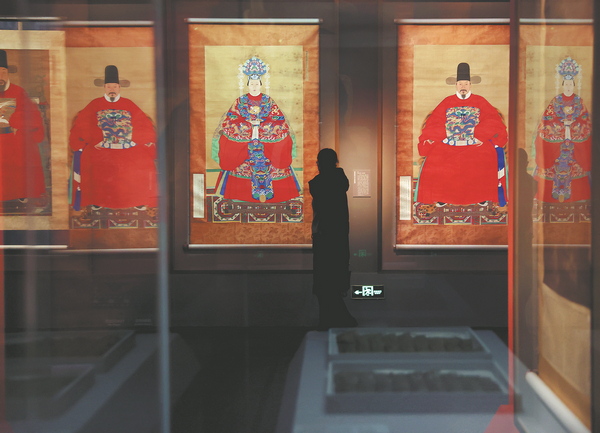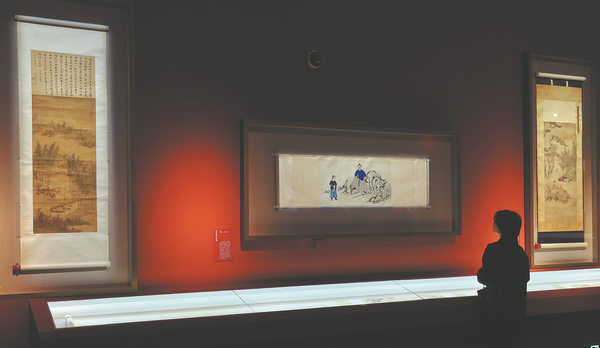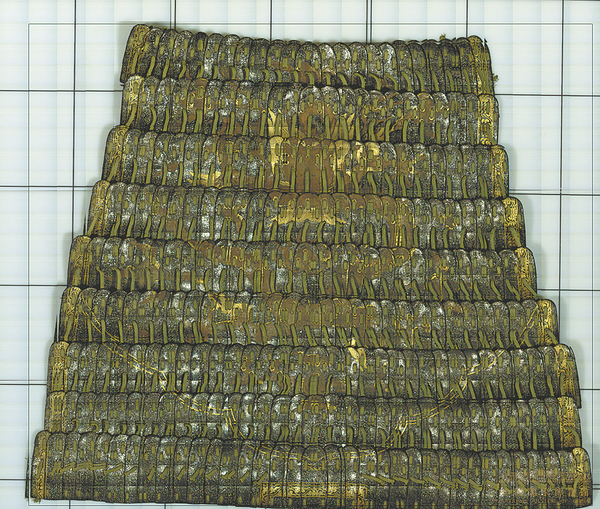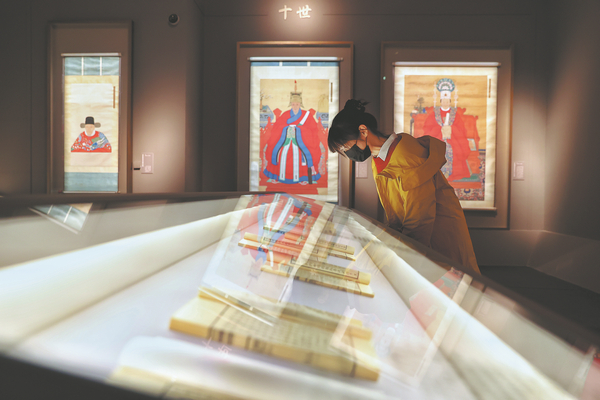The Li family's Ups and Downs

A visitor examines ancestors' portraits of Li Wenzhong's family at the Legacy From the Prince of Qiyang, a long-term exhibition at the National Museum of China that traces the ups and downs of the Li family from the Ming Dynasty (1368-1644). JIANG DONG/CHINA DAILY
A national museum is staging an exhibition dedicated to the eminent lineage instrumental in the vicissitudes of China's final two dynasties, Lin Qi reports.
On a winter day in 1354, Li Wenzhong and his father Li Zhen finally made it to Chuzhou in Anhui province. This was where Zhu Yuanzhang — the younger brother of Li Wenzhong's mother — had stationed his rebel military force during the instability caused by the collapse of the Yuan Dynasty (1271-1368).
Setting off from their plague-stricken village a month earlier, the father and son survived hunger, exhaustion and fighting between different rebel factions on the way, which, on several occasions, almost claimed their lives.
Zhu, who would become the founding emperor of the Ming Dynasty (1368-1644), was saddened when he learned that his sister had died of an illness and adopted his nephew, Li Wenzhong, providing him with care and education, and making him one of the few learned people in his orbit.
Zhu was not acting purely out of a strong sense of kinship, but also out of gratitude. Zhu came from a destitute family with many children, and when he had been younger, he had often been taken care of by Li Wenzhong's parents.
As the years passed, Li Wenzhong became a capable general, winning battles and helping his uncle establish his sovereignty. He went on to serve in a number of important positions in Zhu's court, and was later granted the title of the prince of Qiyang. This prestige was to benefit his descendants for generations over the course of the next six centuries.

More than 70 objects are on show, including Chinese paintings. JIANG DONG/CHINA DAILY
In time, the Li family amassed a trove of portraits, pedigree charts, ceremonial outfits, documents and other objects that belonged to their ancestors, as evidence of their glorious past. These objects later became part of the collection of several museums, including the National Museum of China, which has just mounted a new exhibition to show them.
Legacy From the Prince of Qiyang, a long-term exhibition that gathers together more than 70 objects, traces the ups and downs of the Li family, starting with Li Zhen and Zhu Fonyu, Li Wenzhong's parents, right through to the political turmoil and drastic changes that resulted from the eventual fall of the Ming Dynasty, and its replacement by the Qing Dynasty (1644-1911).
The Li family enjoyed prominence and respect for so long — not just because of the close relations between Zhu Yuanzhang and Li Wenzhong and his parents, but also because several key family members consolidated their prestigious status with displays of courage, intelligence and loyalty, especially to Zhu Yuanzhang, whose mistrust of his court officials intensified in the years following his seizure of the throne.

A leather piece of armor once worn by Li Wenzhong. COURTESY OF NATIONAL MUSEUM OF CHINA
Zhu Yuanzhang ranked Li Wenzhong as the fourth statesman of great merit in the establishment of the Ming Dynasty, as during the early stages of the dynasty, he continued to pacify rebels, helping to stabilize his uncle's rule.
On display are two pieces of leather armor that once protected Li Wenzhong's chest and back and which symbolize his illustrious military service. "They are coated with black lacquer and seashell powder and patterned with gold," says Hu Yan, a curator at the National Museum of China. "The pieces of armor were restored before the show, and the last time they were on display was in the early 20th century."
After Li Wenzhong died, his two sons, Li Jinglong and Li Fangying, carried on the family's close relations with Zhu Yuanzhang. The emperor entrusted the elder, Li Jinglong, with important military undertakings, and often called Li Fangying to court and to check his progress in mastering classic texts.
On one occasion, Zhu Yuanzhang was so pleased with Li Fangying's development that he rewarded the young man with a steamed bun wrapped in his handkerchief. That handkerchief was later venerated at the family's ancestral temple, and Li Jinglong wrote about it in a note which, together with the handkerchief, is also on display.

Objects, such as books and paintings, that were once owned by the Li family on show. JIANG DONG/CHINA DAILY
But as the old Chinese idiom goes, "serving an emperor is as dangerous and uncertain as being close to a tiger", and even Li family members related to the emperor faced challenging situations.
As the emperor aged, he became more suspicious and cruel. On several occasions, Li Wenzhong admonished him to kill less and be more alert to the over-participation of eunuchs in governance, which ultimately angered the emperor.
Hu says there were 12 generations of the Li family during the Ming era. Besides his military talent, Li Wenzhong was widely read and well-versed in poetry, and both became traditions carried on by his descendants.
By the time of the Qing Dynasty, the family no longer held a prince title, and paid as much attention as possible to education and the pursuit of morality.
Hu says that to give visitors a more vivid experience of the Li family's heyday, four different formal outfits once worn by senior family members have been restored to their original glory.
"The rise and decline of such an eminent family will help visitors to the exhibition to better understand the course of the two dynasties and evolution of history," Hu adds.
Contact the writer at linqi@chinadaily.com.cn